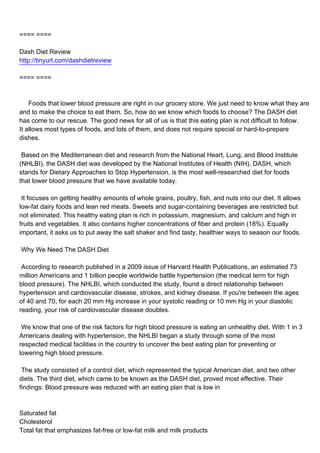
Is This The Dash Diet of 2012
- 1. ==== ==== Dash Diet Review http://tinyurl.com/dashdietreview ==== ==== Foods that lower blood pressure are right in our grocery store. We just need to know what they are and to make the choice to eat them. So, how do we know which foods to choose? The DASH diet has come to our rescue. The good news for all of us is that this eating plan is not difficult to follow. It allows most types of foods, and lots of them, and does not require special or hard-to-prepare dishes. Based on the Mediterranean diet and research from the National Heart, Lung, and Blood Institute (NHLBI), the DASH diet was developed by the National Institutes of Health (NIH). DASH, which stands for Dietary Approaches to Stop Hypertension, is the most well-researched diet for foods that lower blood pressure that we have available today. It focuses on getting healthy amounts of whole grains, poultry, fish, and nuts into our diet. It allows low-fat dairy foods and lean red meats. Sweets and sugar-containing beverages are restricted but not eliminated. This healthy eating plan is rich in potassium, magnesium, and calcium and high in fruits and vegetables. It also contains higher concentrations of fiber and protein (18%). Equally important, it asks us to put away the salt shaker and find tasty, healthier ways to season our foods. Why We Need The DASH Diet According to research published in a 2009 issue of Harvard Health Publications, an estimated 73 million Americans and 1 billion people worldwide battle hypertension (the medical term for high blood pressure). The NHLBI, which conducted the study, found a direct relationship between hypertension and cardiovascular disease, strokes, and kidney disease. If you're between the ages of 40 and 70, for each 20 mm Hg increase in your systolic reading or 10 mm Hg in your diastolic reading, your risk of cardiovascular disease doubles. We know that one of the risk factors for high blood pressure is eating an unhealthy diet. With 1 in 3 Americans dealing with hypertension, the NHLBI began a study through some of the most respected medical facilities in the country to uncover the best eating plan for preventing or lowering high blood pressure. The study consisted of a control diet, which represented the typical American diet, and two other diets. The third diet, which came to be known as the DASH diet, proved most effective. Their findings: Blood pressure was reduced with an eating plan that is low in Saturated fat Cholesterol Total fat that emphasizes fat-free or low-fat milk and milk products
- 2. The eating plan also included lots of fruits and vegetables. Doctors saw immediate reductions in blood pressure rates, within two weeks, in those following the DASH eating plan. The importance of these findings cannot be overestimated: With the DASH findings, we now know how to reduce the risk for the two major diet-related causes of strokes and heart disease: cholesterol and high blood pressure. A second study added a reduction in sodium (salt) intake to the DASH plan. Participants who followed the DASH plan and ate 1500 mg (2/3 tsp) or less of salt daily saw a significant further decrease in their high blood pressure levels. Tips for Eating Foods That Lower Blood Pressure Eat fresh (vegetables, fruits). Make complex carbohydrates (whole grains, such as pasta) central to your meal. Make meat a side dish, not the main dish. Eat lean meats, poultry, and fish. Eat a variety of colors, textures, and tastes, so you don't get bored and go back to old habits.. Steam, grill, roast, stir-fry; don't fry. Eat fruit and other tasty table sugar substitutes. Create your own mixture of seasonings to bring out the flavors of food and reduce salt. Rinse off salt from canned foods and cured foods if you eat them. Modify your favorite recipes to incorporate DASH diet principles. Make gradual changes. Source:EzineArticles ==== ==== Dash Diet Review http://tinyurl.com/dashdietreview ==== ====